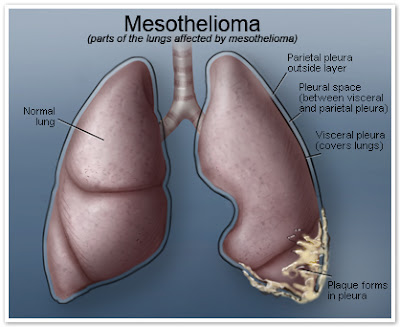PATHOLOGY AND THE ROLE OF PATHOLOGISTS IN THE DIAGNOSTIC PROCESS
Pathology, or the scientific study of cells, tissue, or fluid taken from the body is an integral part of a mesothelioma diagnosis. Most hospitals have their own pathology labs staffed by board-certified pathologists and licensed technologists. The importance of pathological diagnosis can not be underestimated, since the course of treatment is dependent upon an accurate diagnosis.
To make a diagnosis, pathologists examine tissue under a microscope, and based on established criteria, make a determination of benign vs. malignant cells. (More on biopsy tissue processing.) Subsequently, the type of cancer is determined. Although most pathologists have a general expertise of various diseases, a small number acquire training in a subspecialty, such as mesothelioma. These are physicians who have received world-wide recognition as premier experts, and have achieved high acclaim for their research, published articles and abstracts, and teaching. For a list of expert pathologists in the field of mesothelioma diagnosis, please call the MW toll free at 1-877-367-6376 or fill in the form at the bottom of this page specifying your request.
Knowing the stage is a factor in helping the doctor form a treatment plan. Mesothelioma is considered localized if the cancer is confined to the pleura, or advanced if it has spread beyond the pleura to other parts of the body such as the lungs, chest wall, abdominal cavity, or lymph nodes.
Immunohistochemical Markers for Mesothelioma
A diagnosis of any specific type of cancer often means ruling out other cancers in the process. This is true in the case of mesothelioma, where the most common “differential diagnosis” is that of adenocarcinoma versus mesothelioma.
During the biopsy procedure, the surgeon removes tissue samples to be sent to the laboratory. In the lab, slides are produced and then viewed and analyzed by a pathologist. These tissue specimens arrive at the lab with a request form that details patient information and history along with a description of the site in the body from which the specimen was obtained. Each individual specimen is numbered for each patient.
The pathologist then does a “gross examination” which consists of describing the tissue, and then placing it in a plastic cassette. The cassettes are then placed in a fixative that preserves the tissue permanently. Once the tissue has been fixed, it is processed into a paraffin block that will allow the pathologist to slice off thin microscopic sections that will then be stained to determine the patient’s diagnosis.
Immunohistochemistry is defined as “a method of analyzing and identifying cell types based on the binding of antibodies to specific components of the cell”. It is this process that helps diagnose mesothelioma versus adenocarcinoma (or other types of cancer).
Early on, the “markers” which helped distinguish mesothelioma from adenocarcinoma were “negative markers”; those expressed in adenocarcinomas, but not in mesotheliomas. This made it more difficult to confirm a diagnosis, because pathologists were dealing with the absence of, rather than the presence of certain markers. Some of these markers, which are normally “positive” in an adenocarcinoma diagnosis and “negative” in a mesothelioma diagnosis, are carcinoembryonic antigen (CEA), CD 15 (LeuM1), epithelial glycoprotein (Bg8), tumor glycoprotein (BerEp4) and tumor glycoprotein (MOC-31).
In more recent years, “positive markers” expressed by mesotheliomas have come to the forefront. Some of the markers which are normally “positive” in mesotheliomas and “negative” in adenocarcincomas are calretinin, cytokeratin 5, HBME-1, mesothelin, N-cadherin, thrombomodulin, vimentin and Wilm’s tumor gene product (WT-1). In 2009 the International Mesothelioma Interest Group (a collection of doctors specializing in mesothelioma) put forth “Guidelines for pathologic diagnosis of malignant mesothelioma.”
It is important to remember that while the above markers are commonly used to help diagnose the epithelial sub-type of mesothelioma, that they may also be expressed in other types of cancer, and may not necessarily apply to the bi-phasic or sarcomatoid sub-types of mesothelioma. Your doctor can always contact a more specialized lab if he/she feels your diagnosis is in any way inconclusive.













